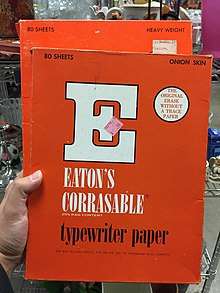Eaton's Corrasable Bond
Eaton's Corrasable Bond is a trademarked name for a brand of erasable typing paper. Erasable paper has a glazed or coated surface which is almost invisible, is easily removed by friction, and accepts typewriter ink fairly well. Removing the coating removes the ink on top of it, so mistakes can be easily erased once. After erasure, the correction is typed onto an unprotected paper surface and cannot be easily erased a second time.

Because the coated surface does not absorb ink, erasable paper is apt to smudge. Since the coating is intended to be easily removed by friction, the typed pages are not very durable. Under some storage conditions, the coating is apt to make pages stick together. Erasable paper is not suitable for legal documents or archival records.[1] It was available in a number of thicknesses.[2]
Eaton's Corrasable Bond is no longer manufactured.
In the United States, Eaton's Corrasable Bond was a very familiar brand of erasable typing paper during the mid-1950s and 1960s, and "corrasable" became almost a generic name for erasable typing paper. For example, in prohibiting the use of such paper for manuscript submissions, the Linguistic Society of America refers to "Eaton's 'Corrasable Bond' and similar brands."[3]
Writer Peter David, who worked as an editor's assistant at the E. P. Dutton imprint Elsevier/Nelson before becoming a professional writer, once related finding a submission written on erasable bond, which made the print difficult to read.[4] In a 1992 Comics Buyer's Guide column in which he provided aspiring writers with tips on composing submissions, he stated, "Don't write on anything other than standard-weight white bond paper. I don't care what Abe Lincoln or Jack Kerouac wrote on; you're not Lincoln or Kerouac. And for crying out loud, don't use erasable bond. That wasn't a dodge the writer used in Misery to get Annie out of the house; no real writer types on erasable bond."[5]
In fiction
The paper is mentioned in the Stephen King novel Misery, when Annie Wilkes buys it for Paul Sheldon, thinking that since it is the most expensive paper, it has to be the best. When Paul shows Annie that Corrasable Bond is smudge-prone, and hence detested by editors, Annie thinks he is being ungrateful and, in a fit of bad temper, smashes the ream of paper down onto a sitting Paul Sheldon's knees and thighs, causing his still-healing legs agonizing pain.
"Divorce or Corrasable Bond" is a poem by Daniela Gioseffi.[6]
In the tenth chapter of Sylvia Plath's The Bell Jar, Esther, the main character, mentions this paper when she sets up a place to start writing a novel. "I counted out three hundred and fifty sheets of corrasable bond from my mother's stock"...
In the first chapter of T.C. Boyle's Outside looking in, there is a Ford Fairlane that has tires "worn as smooth as the sheets of Corrasable Bond". [7]
References
- Listserve 14.5. Miami University. December 6, 1996. Retrieved September 20, 2012.
- "NOT A SIGN OF A SLIP-UP!". The Tech. October 14, 1960. Page 2.
- "LSA Style Sheet for Publications of the Linguistic Society of America". University of Michigan. 1988. Retrieved September 20, 2012.
- David, Peter. "Where Man Josh". peterdavid.net. September 17, 2012. Originally published in "But I Digress..." Comics Buyer's Guide #1260 (January 9, 1998)
- David, Peter. "Breaking In". But I Digress. 1994. Krause Publications. Page 98. Originally published in Comics Buyer’s Guide #976 (July 31, 1992).
- Gioseffi, Daniela (February 1, 2000). "Divorce or Corrasable Bond". Pif Magazine.
- T.C. Boyle, "Outside looking in". . tcboyle.com.
In Sylvia Plath's only novel The Bell Jar the main character Esther uses it. “I counted out three hundred and fifty sheets of corrasable bond from my mother's stock in the hall closet,”
Excerpt From: Administrator. “Microsoft Word - Plath, Sylvia - The Bell Jar.” iBooks. This material may be protected by copyright.